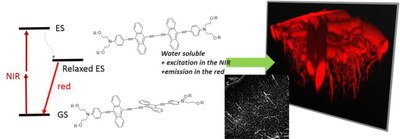Intravital imaging
We designed original polymeric platforms for dyes transport in biological media based on an innovating hydrosolubilization approaches (New J. Chem., 2012, 36, 2322). This approach led to the design of an highly efficient candidate for angiography applications, by using an chromophore in which the fluorescence strongly increases and is significantly red-shifted with solvent polarity.(Chem. Sci. 2013, 4, 2833–2843). This work, which has already been the subject of a CNRS press release, was reported in the french scientific newspaper La Recherche of August 2013 and in the special issue « L’album de l’année 2013 : les 100 plus belles images de la science», as well as in more than 100 scientific sites and blogs.

Legend...
By modifying the nature of the polymer/fluorophore couple, we are able to obtain unprecedented selectivity for different biological compartments. For instance, accumulation of one of the probes within the endothelial walls of blood vessels has been clearly assessed, which allows to perform permanent vascular marking that can be used in the framework of histological microscopy imaging.
Further modifications of the polymer backbone are currently undertaken, with the aim to improve their affinity towards biopolymers, such as DNA or proteins (PhysChemChemPhys,2015, 17, 30318)




